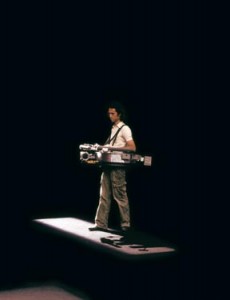« Features
ARCOmadrid-2009: A Game of Strategy

Lawrence Malstaf . Compass. 02005, 2008. Aluminium structure, electronics.Diameter 39.4”. Copyright Lawrence Malstaf and Galerie Fortlaan 17
By Janet Alfonso
The 28th edition of the international art fair, ARCOmadrid-2009, made it clear that the current economic crisis has been manageable, as far as the art market is concerned.
Fairs are social, economic and cultural events; in recent decades, however, the second of these aspects has become more prominent. Sales outcome, in terms of pricing and volume, has come to determine the relevance of these types of encounters. ARCO cannot escape this dynamic, although it does try to promote dialogue among very different artistic practices.
This year, the spectator was able to choose his own path, in accordance with his own interests, with the establishment of three pavilions and the distribution of artworks in separate spaces (Expanded Box, Solo Projects, ARCO 40, Cinema, and Performing ARCO, in addition to the General Program). The space was treated in a more coherent way, avoiding some of the pitfalls of prior editions. Rest areas were opportune, although insufficient. However, the absence of carpeting was evident in some booths (in which the unevenness of the floor tended to negate the exhibited artwork) and many of us had the sensation that various galleries were getting lost within the confines of the exhibition site.
Are some galleries’ sales enhanced to the detriment of others as a result of their spatial location, strategically speaking? Do the location and condition of a booth depend on the budget or quality of the exhibited artwork? Let us not deceive ourselves. At ARCO, as in other fairs, the place you occupy at the event will affect your positioning in the international art market.
An interesting detail was that during this fair we attended magnificent award ceremonies, at which galleries with prizewinning artworks were noticeably absent. It is clear that, in this context, cultural significance has been displaced by an interest in sales.
Nevertheless, the merit of ARCO’s strategy is undeniable, a fair for all tastes and pocketbooks. The variety of works demonstrated this: from pieces by the most sought-after creators of the 20th and 21st Centuries to the production of emerging artists. The price differential was equally outrageous: from 15,700,000 euros assessed for a work by Francis Bacon to 280 euros for a Roberto Matta engraving.
As a point in its favor, the fair has opened its doors to the so-called “emerging markets,” which in other words are the new capitals of money, those countries that are changing the polarity of the art market. We are speaking of China, India, Brazil, Turkey and other countries of the Middle East. If we consider that Indian artists are currently selling for millions in major auction houses worldwide, it should come as no surprise that in this edition India was the invited country.
In summary, the economic outcome of ARCOmadrid-2009 was satisfactory. As predicted, the crisis appears not to have passed through there.
THE ARTWORKS
Paintings and photography prevailed in this edition. Some projects stood out and surpassed all expectations.
Such is the case with Arrow Wall, an interactive installation by the Indian artists, Pors & Rao - white paintings with small black arrows that appear or disappear as the spectator approaches or draws back. The work reacts, moves, changes, deconstructs or rearranges depending on how it is observed, consumed or analyzed.
Furthermore, the Belgian, Lawrence Malstaf, redefines the artistic object. He builds machines to elicit intense physical experiences. With Compass.02005, by placing the machine on the visitor’s waist, he tries to have it guide him through virtual or physical hallways. It is programmed to generate brusque changes in the direction of the individual’s movements, in order to bring on strong feelings of attraction or repulsion. The public passes from being a spectator to a protagonist, in a space scenographically recreated with sketches, photos, lights and texts. It is a kind of laboratory art.
An awesome piece is 144,58 Nm by the Chinese artist, Shi Jinsong. A jade head resting on a mechanical base repeatedly bangs up against a brick wall. The combination of materials and the dull sound of the impact speak of the contradiction, impotence, effort and zeal of a will resolved to liberty. In the piece, the jade head remains pristine; the hole is in the wall.
For his part, Ori Gersht works with photography and video on themes that overwhelm the human mind: death, transience, chaos. In Time After Time he freezes flower bouquets in liquid nitrogen, makes them explode and captures the moment of destruction at 1600 stills per second. Videos like Pomegranate and Falling Bird have impressive visual strength and resounding beauty, intensified through a combination of silence and sound.
Indian artist, Jitish Kallat, loves paradoxes and Mumbai presents him with stimulating contradictions. Abundant traffic accidents remain trapped in the resin of his sculpture Petrum Opus. In Traumanama (The Cry of the Gland), urban collapse and overpopulation emerge as muscles and bones, the almost genetic trauma of the city. In other works, such as, Aquasaurus he features the water shortage. The piece is a colossal tank truck structure, made from simulated prehistoric bones, which turns into a defiant animal with sharpened teeth and an empty stomach.
There is impeccable beauty in the work of Korean artist, Hye Rim Lee, who deals with the world of virtual relationships using sophisticated computer programs. In Touch My Tit, with cool tones and an explicit title, this creator explores instinct, fantasy and sexual innuendo through mythological elements of identity, like the dragon.
Finally, it is well worth mentioning that, in this edition of the fair, high-quality projects came through independent curators. This highlights the task of the curator who tries to overcome the obstacles of rigid institutionalization in order to provide new artists with alternative access to the contemporary art market.
Janet Alfonso: Art critic and historian based in Madrid.


































